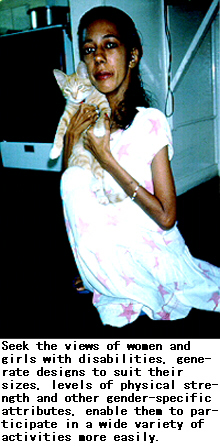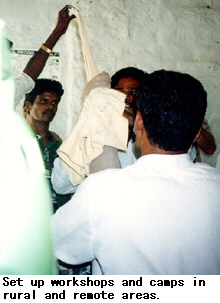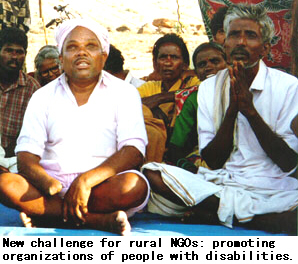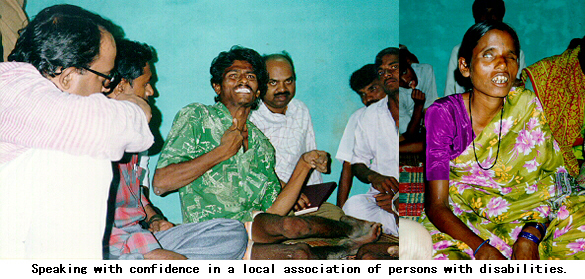RECOMMENDATION

This chapter recommends courses of action for key groups and individuals concerned with assistive devices, based on the information about the region's needs contained in the rest of the publication. Recommendations intended specifically for Governments are contained in the sample national policy and plan. However, those Governments that have an interest in designing, producing and distributing assistive devices will also find this chapter of interest.
A. Device designers
Those creating new indigenous designs of assistive devices, especially those involved in organized R&D, could:
- Involve and consult potential users, as well as rehabilitation personnel and local artisans and mechanics, in every stage of the indigenous design process.
- Actively seek the views of women and girls with disabilities to generate designs which meet their needs for devices (appropriate to their sizes, levels of physical strength and other gender-specific attributes) that enable them to undertake a wide variety of activities more easily.
- Organize national seminars to bring together technicians and specialists (with or without certification) in a forum for technical exchange and to forge a sense of common identity and purpose among those engaged in the field of assistive devices.
- Closely follow new developments in assistive devices and related fields, in developed and developing countries, that can be used in indigenous research.
- Design mobility devices with sturdy lightweight materials and large bases, which make them more appropriate for indigenous housing patterns and the soil and physical conditions of rural areas in the region, such as sandy surfaces or mountainous terrain.
B. Producers
Those producing assistive devices and device components could:
- Adopt a decentralized approach to producing most assistive devices, in order to best meet user needs. Only the least user-specific devices should generally be mass-produced.
- Mass-produce components in order to bring down the cost of producing finished assistive devices. This is especially important for components made of new materials (e.g., thermoplastics and titanium), which require high initial investments for special production facilities and must therefore be manufactured in large numbers to minimize costs.
- Set up production facilities for new assistive devices through equity participation with companies from other countries that have the technology.
C. Health-care personnel
As they have the responsibility to rehabilitate people with disabilities and prescribe assistive devices, health-care personnel could:
- Learn about assistive devices from knowledgeable users and technicians who work on assistive devices, so that they may acquire an understanding of what technical specifications may be most appropriate in a particular case, based on interviews with users and physical examination of measurements.
- Acquire an understanding of user lifestyles to facilitate correct decisions on what devices to prescribe (see Box 13 for a sample list of interview questions).
- Inform users about the proper use, repair and maintenance of their own assistive devices when initiating them into the use of prescribed devices.
- Prescribe prostheses that are suitable for stumps of irregular shapes and sizes, rather than insisting on standards of amputation that are not feasible in many developing countries.
D. Distributors and repair personnel

Government agencies, NGOs and private-sector agencies involved in distributing, repairing and maintaining assistive devices should:
- Extend their services to rural areas away from capitals and their peripheries, since these areas are the most under-served.
- Set up workshops and camps to produce and repair assistive devices in rural and remote areas and make it easier for geographically dispersed users to acquire the devices and have access to repair services.
- Carefully consider the logistics involved in planning mobile workshops and organize access to adequate facilities, to cover the areas for mobile workshop services.
- Organize camps on a continuous basis with good record-keeping and coordination among concerned agencies, in order to provide adequate follow-up services. Funds should be available for the camp-related expenses of the rehabilitation team and its transportation, board and lodging.
- Record basic information (names, addresses and types of devices) obtained from recipients of assistive devices, and regularly organize opportunities, either through annual get-togethers or home visits, for consultation with them to follow up on the continuing appropriateness of their devices.
- Ensure that information concerning assistive devices reaches women and girls with disabilities in appropriate language and formats, and that services are organized in a gender-sensitive manner to facilitate their equal access.
- Pay special attention to the needs of children, as they soon outgrow their assistive devices and need regular follow-up to replace or update the devices.
- Ensure that the methods used for distribution of devices (e.g., camps and mobile workshops) are also used to provide repair and maintenance services, with particular attention to appropriate ways of meeting the needs of women and girls with disabilities.
- Introduce only those technologies that are appropriate to local cultural, physical, infrastructural and economic conditions and are likely to be sustainable without the presence of technicians from outside the area who may not stay on permanently.
- Obtain all instruction, maintenance and repair manuals (and circuit diagrams, if applicable) for devices that are imported, especially those that have electronic or electro-magnetic components, to facilitate local maintenance and repair of the devices.
- Ensure that devices provided for use in daily life are indeed designed for daily life, and not for the limited options of a short-term stay in a hospital or similar institution.
- Maintain a stock of temporary devices to loan to people with disabilities while their own devices are repaired.
- Display every type of assistive device distributed along with the conditions for obtaining them and/or the prices, so that people who need devices can see and select which devices are most suitable to them.
E. People with disabilities

People with disabilities and their families, communities and helpers could:
- Organize meetings where they can discuss their problems and solutions concerning the use of assistive devices. This would help develop a sense of community among users of assistive devices and facilitate appropriate collective responses to basic problems, especially those faced by all users. It could also encourage new users among other people with disabilities who may previously have been ignorant of, or hesitant to use, assistive devices.
F. Rural development organizations and agencies
NGOs and government agencies active in rural areas but not generally dealing with disability matters could:
- Create community awareness about people with disabilities and assistive devices.
- Foster community action to enable people with disabilities to participate in community programmes.
- Facilitate the formation of self-help groups among people with disabilities.
- Start small community workshops to produce assistive devices.
- Pay special attention to the production of devices appropriate to local women and girls with disabilities.
G. National governments, and regional and international organizations
National government agencies as well as regional and international organizations should:
- Strengthen active regional information exchange concerning assistive devices, by working towards the creation of an information and database, to collect from within and outside the ESCAP region information on technology and techniques, for wide dissemination in the ESCAP region.
- Support technical cooperation among developing countries (TCDC) to assist in
- (i) Matching specific needs with available resources and expertise within the ESCAP region;
- (ii) Developing means of training more technicians in the indigenous production and distribution of assistive devices, with emphasis on training people with disabilities as well as their family and community members;
- (iii) Strengthening the training of engineers and applied scientists to enhance their contributions to indigenous research and design for improved production of low-cost, high-quality and culturally appropriate devices for the poor.
- Develop effective approaches to:
- (i) Disseminate indigenous knowledge concerning assistive devices, to ensure that semi-literate and illiterate communities have access to assistive devices and related services available within the country;
- (ii) Harness community skills, especially among mechanics, craftpersons, health workers, community workers and technicians, for enhancement of local innovation, production, distribution, and follow-up services, including repair and maintenance.

Go back to the Contents
ECONOMIC AND SOCIAL COMMISSION FOR ASIA AND THE PACIFIC
Production and distribution of assistive devices for people with disabilities: Part 1
- Chapter 11 -
Printed in Thailand
November 1997 1,000
United Nations Publication
Sales No. E.98.II.F.7
Copyright c United Nations 1997
ISBN: 92-1-119775-9
ST/ESCAP/1774
